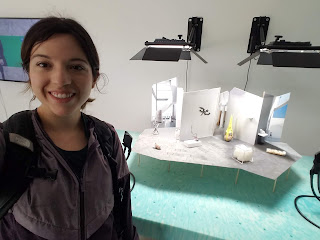Extra Credit Event: Weak Or No Signal

This quarter, I had the opportunity to attend the UCLA DESMA Master's of Fine Arts showcase for the graduating class of 2018. This was undoubtedly one of the more interesting events I have attended that relate to the DESMA field because it was visually interactive. If a picture is worth a thousand words, then an MFA project is worth a million because of the amount of effort put in. For this particular exhibit, it was evident how the projects utilized technology to their advantage. A Selfie with Home-like Artwork Electronic Jacket One of the first pieces I saw was an electronic jacket. It could flash lights down the length of the arm and was wired extensively. This product proved a unique approach to wearable technology, as it introduced tech to an article of clothing as opposed to being a typical accessory add-on. This reminded me of the lecture by Waseda University professor, Machiko Kusahara, who shared that the future of robotics is shifting towards more people-relati...

